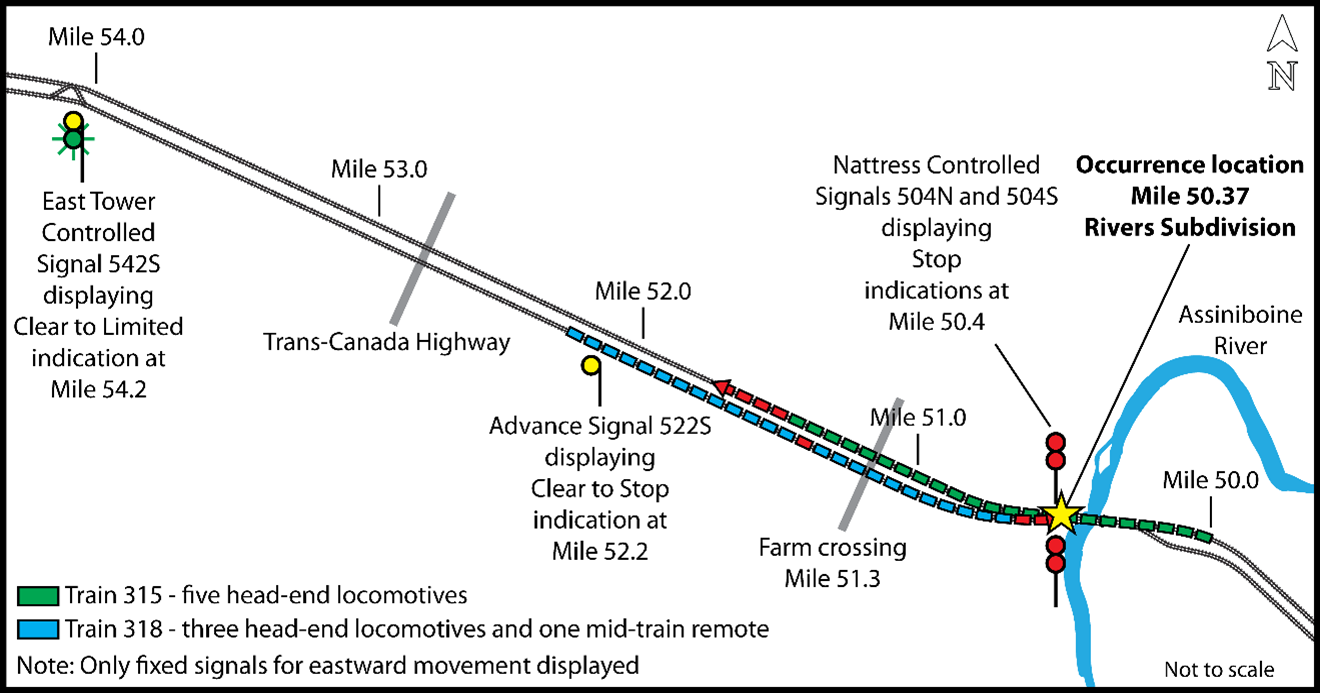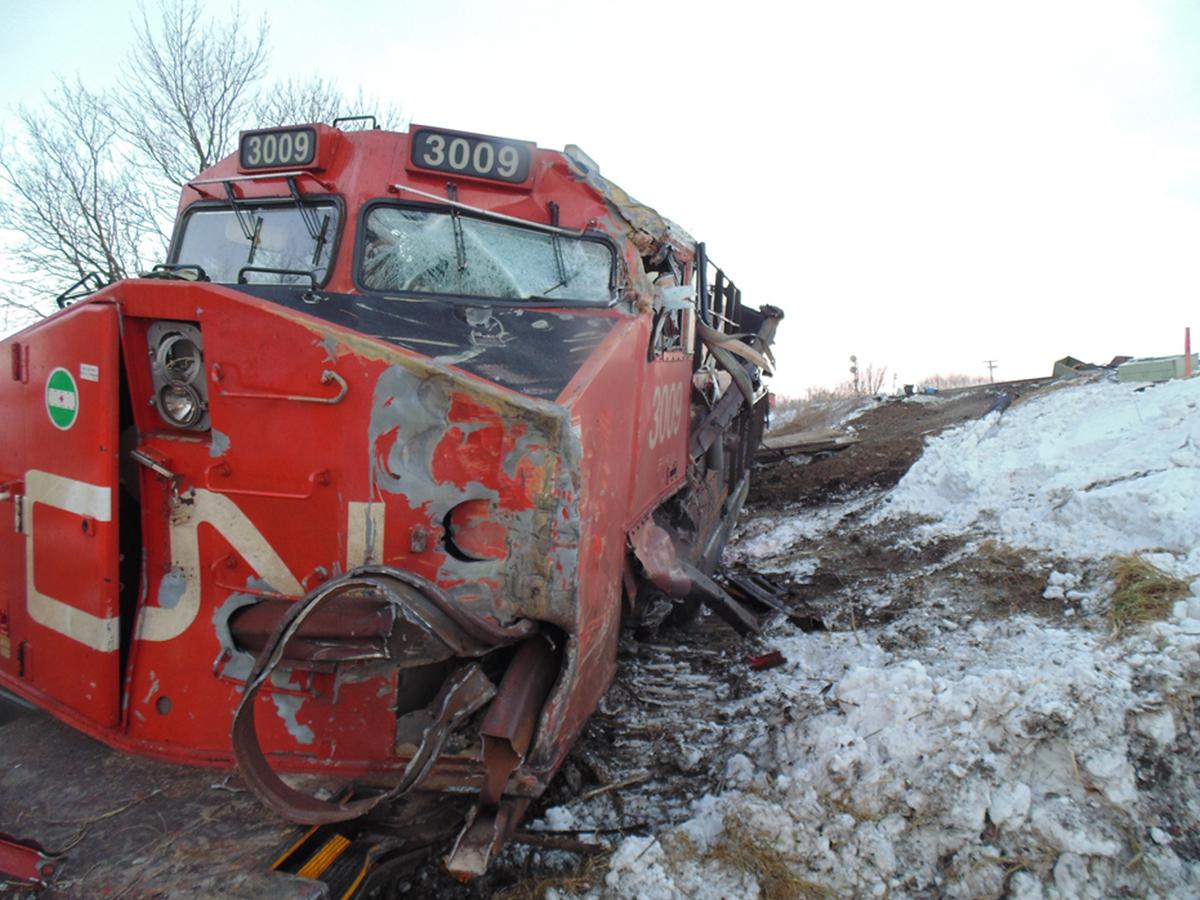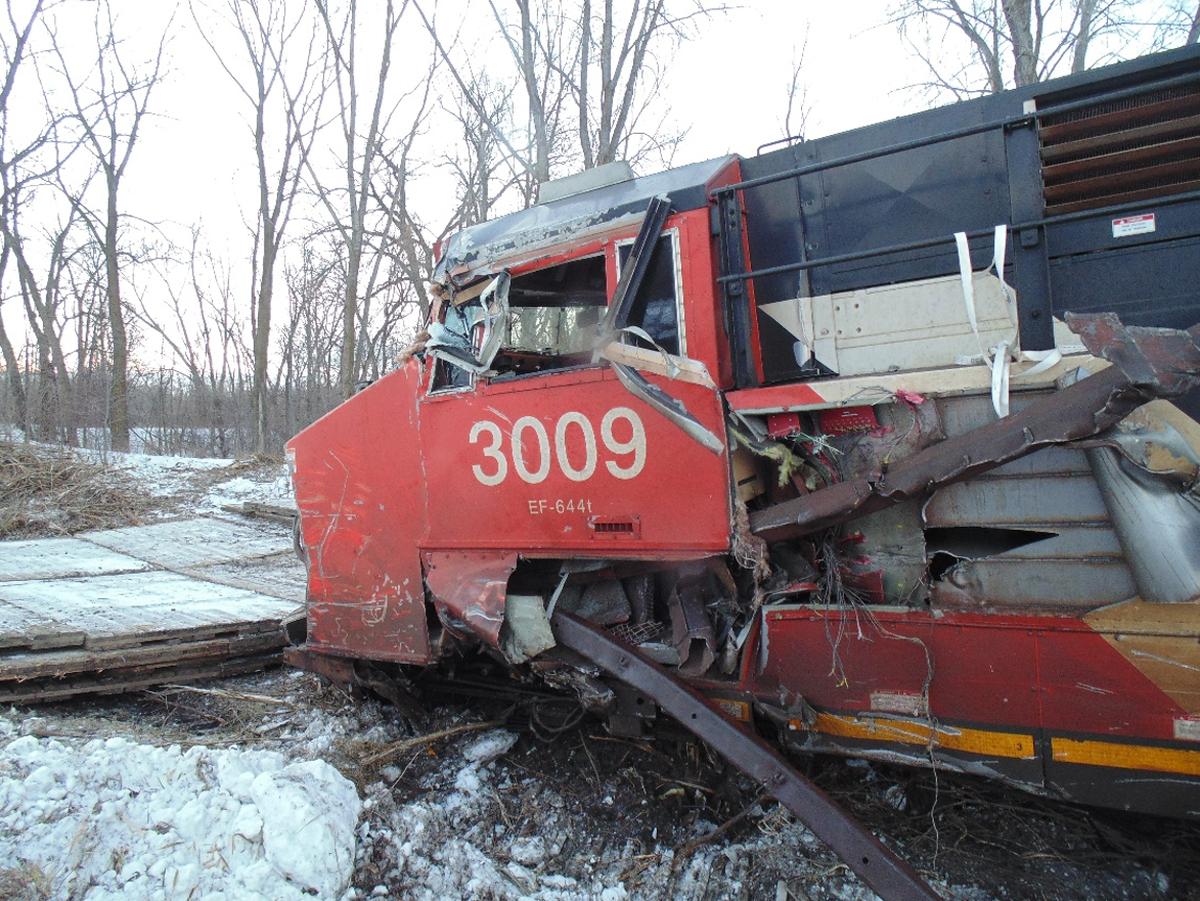Main-track train collision and derailment
Canadian National Railway Company
Freight trains M31851-01 and M31541-03
Mile 50.37, Rivers Subdivision
Portage la Prairie, Manitoba
The occurrence
On 03 January 2019, about 0610 Central Standard Time,Footnote 1 Canadian National Railway Company (CN) eastbound freight train M31851-01 (train 318) began following eastbound CN train Q11651-30 (train 116) near Rivers, Manitoba, on the CN Rivers Subdivision. Both trains were destined for Winnipeg, Manitoba. Train 318 was a key trainFootnote 2 operating on a key route,Footnote 3 as defined by the Transport Canada (TC)–approved Rules Respecting Key Trains and Key Routes.
At 0906:54, train 318 was travelling at 42 mph, with Trip Optimizer (TO) engaged and the throttle in position 7, as it passed a Clear to Stop signal indication at Mile 52.2. The conductor had called out the signal in the locomotive cab and identified the Clear to Stop indication. However, the conductor did not hear the locomotive engineer (LE) verbally respond to acknowledge the signal, and the LE appeared to be staring straight ahead. At this point, conversation in the cab ceased. TO remained engaged, and the train continued at track speed.
As CN train 318 was proceeding on the south track, a westbound CN freight train M31541-03 (train 315) was transitioning from single track to the north track while exiting the equilateral turnout (Mile 50.37) at Nattress near Portage la Prairie, Manitoba.
At Mile 51.13, while travelling at 46 mph, train 318 passed the head end of train 315. The train 318 conductor then reminded the LE that they were operating under a Clear to Stop indication. Once reminded, the LE disengaged TO and made a full service brake application at 0908:34; 24 seconds later, he inadvertently placed the brake handle into the suppression position (rather than the emergency position), and then applied the locomotive independent brake. After a further 10 seconds, as Stop Signal 504S came into view, the LE placed the train in emergency and the crew evacuated the locomotive cab.
Train 318 side-collided with train 315 while travelling at 23 mph (Figure S1). Shortly thereafter, the train 318 crew members jumped from the locomotive to the south side of the track and sustained minor injuries.
As a result of the collision, the 2 head-end locomotives on train 318 and 8 cars on train 315 derailed. Although no cars loaded with dangerous goods were involved, the head-end locomotives on train 318 lost a combined total of about 3500 imperial gallons of diesel fuel. The released diesel fuel was contained locally and cleaned up with no waterways affected.
The investigation concluded that:
- The train 318 crew had formed the expectation that they would follow train 116 clear through to Winnipeg, without stopping at Nattress, because that is what had happened on the previous 9 eastbound trips along the Rivers Subdivision.
- Train 318 had accelerated to 42 mph by the time it encountered Advance Signal 522S. From that point on, the train 318 crew should have been preparing to stop the train before arriving at Signal 504S at Nattress.
- The train 318 operating crew did not respond appropriately to the signal indications displayed in the field at Mile 52.2 and Mile 50.4, which ultimately led to the collision.
- The train 318 LE was fatigued due to acute sleep disruption brought on by abbreviated and disrupted sleep periods during the 2 nights preceding the accident.
- The train 318 LE experienced decreased vigilance due to the reduced workload while using TO and due to the performance decrements associated with his fatigue, which contributed to his delayed reaction to the restrictive signals at Mile 52.2, and to him selecting an inappropriate braking technique when initially trying to stop the train.
- Due to the inexperience of the train 318 conductor and the authority gradient that existed between the crew members, the conductor deferred to the LE without questioning the operation of the train and, as a result, the crew’s actions to slow and stop the train before Controlled Signal 504S were delayed and ineffective.
- In the absence of a physical defence such as an enhanced train control system, there was no automatic intervention to slow or stop the train when the crew did not initially respond to the Clear to Stop signal displayed in the field.
Safety action taken
Canadian National Railway Company
Following this occurrence, CN distributed System Notice No. 904 to all operating employees in Canada. The notice warned train crews that there had been an increase in Canadian Rail Operating Rules Rule 439 violations across the CN system because of train crews failing to stop at signal indications requiring them to do so, primarily due to a lack of focus on situational awareness. Notice No. 904 stated that “operating crews must not be influenced by other information such as train lineups, detector broadcasts or other crew’s [sic] broadcasts until they themselves positively identify the next signal.”
Safety action required
Enhanced train control for key routes
The basic design of centralized traffic control (CTC) signalling systems in Canada has been well established for some time. Although newer signal circuitry has been integrated into the CTC system over the years, railway operations still rely predominantly on administrative defences, which are the least effective method for mitigating risk. Administrative defences place an over-reliance on a train crew to follow the rules and do not consider the human factors that affect behaviour. For example, the CTC train control system in this case had the administrative requirement for train crews to follow the signal indications displayed in the field, yet this defence did not prevent the accident from occurring.
A signalled CTC system does not provide any advance warning to either the train crew or the rail traffic controller. CTC also does not provide automatic enforcement to comply with speed restrictions in order to slow or stop a train before it passes a restrictive signal. As a result, when a train crew misperceives, misinterprets or does not follow a signal indication, the administrative defences as a whole fail. As demonstrated in this and 80 other TSB investigations since 1990, when an administrative defence fails and there is no secondary defence, it can result in an accident that otherwise could have been prevented.
For comparison, Class 1 railways that operate in the United States (U.S.) have implemented physical fail-safe train control systems known as positive train control (PTC). PTC is designed to prevent train-to-train collisions, overspeed derailments, incursions into work zones, and movement of a train through a switch left in the wrong position. In Canada, the term “enhanced train control” (ETC) has been adopted to describe such systems.
A PTC/ETC system would address the risk of crews misinterpreting or not following signal indications by automatically intervening to slow or stop a train in the event that an operating crew does not respond appropriately to a signal displayed in the field. A fully functioning PTC/ETC system would also offer a physical fail-safe defence against operating crew errors that are influenced by fatigue, which played a role in this accident.
In the U.S., the Rail Safety Improvement Act (RSIA) of 2008 required that PTC be installed on high-hazard routes; as of 31 December 2020, PTC was fully implemented on all required track, a total of 57 535.7 miles, or about 41% of the nearly 140 000 route-miles of the U.S. rail network. The total miles of track that have PTC installed includes the U.S. operations of both CN (3107 miles) and Canadian Pacific Railway Company (CP) (2118 miles).
In comparison, the Canadian rail network comprises about 26 000 route-miles of track. Key routes account for a combined total of about 10 940 miles of main track, which represents about 42% of the Canadian rail network. However, in contrast to the U.S., there is no requirement to install PTC or ETC on routes that carry dangerous goods in Canada.
Since 2000, the Board has issued 2 recommendations related to the need for additional train control defences:
- Recommendation R00-04 was issued following its investigation into the 1998 collision between 2 CP trains near Notch Hill, British Columbia.Footnote 4 The Board recommended that the railway industry implement additional backup safety defences to help ensure that signal indications are consistently recognized and followed.
- Recommendation R13-01 was issued following a TSB investigation into the 2012 derailment and collision of VIA Rail Canada Inc. passenger train 92 (VIA 92) near Burlington, Ontario.Footnote 5 The Board recommended the implementation of physical fail-safe train controls, beginning with Canada’s high-speed rail corridors.
In 2014, in response to the 2 TSB recommendations, a joint TC–industry train control working group (TCWG) was established and contracted a report from the Canadian Rail Research Laboratory (CaRRL). After these activities, there were a series of ongoing meetings, discussions, and studies related to the development and implementation of ETC systems in Canada with no implementation plan or other tangible results to date. While TC did publish a Notice of Intent in the Canada Gazette, Part I, in February 2022 signalling its intent to require the implementation of ETC in Canada, there is still no implementation plan. In the time it took TC and industry to strike the TCWG, study the issue, produce the TCWG Final Report, contract a follow-on report from the CaRRL and study the CaRRL results, PTC had been fully implemented in the U.S. on all of the high-hazard trackage required by the RSIA legislation.
The CN Rivers Subdivision is a key route and is also an integral part of one of the major rail traffic corridors in Canada. This also means that the cities, towns, and villages along this key route are continually exposed to the risks associated with key trains transporting dangerous goods (DG). Any collision or derailment involving a key train presents a risk of a DG release and potential adverse consequences to people, property or the environment.
The implementation of physical fail-safe train control technologies such as ETC would provide an extra layer of safety when operated in conjunction with existing administrative defences. However, the Canadian railway industry continues to rely solely on administrative defences to protect against train crews not responding appropriately to signal indications displayed in the field.
If TC and the railway industry do not take action to implement physical fail-safe defences to reduce the consequences of inevitable human errors, the risk of collisions and derailments will persist, with a commensurate increase in risk on key routes in Canada. Therefore, the Board recommends that
the Department of Transport require major Canadian railways to expedite the implementation of physical fail-safe train controls on Canada’s high-speed rail corridors and on all key routes.
TSB Recommendation R22-04
Recurrent crew resource management training
In general, railway companies do not use closed-loop communication methods. Rail operating rules require that when a train encounters a signal indication displayed in the field, 1 crew member must communicate the signal indication aloud within the locomotive cab to the other crew member. While the other crew member is required to repeat the message back, there is no requirement for the original sender to confirm that the message was received accurately or understood by the other crew member.
As demonstrated by this occurrence, when there is a significant difference in level of experience between operating crew members, an authority gradient may develop in which the less experienced crew member may not always intervene to ensure compliance with all of the rules. In these situations, there is a danger that safety-compromising behaviour will be overlooked because a less experienced employee may be reluctant to question the actions of a more senior employee or intervene in the operation of the train even when it may be critical to do so, such as occurred in this accident.
Crew resource management (CRM) is a concept introduced in the aviation and marine industries to limit or eliminate human errors by recognizing the importance of cognitive and interpersonal skills, thereby improving safety. CRM training seeks to improve a crew’s skills, abilities, attitudes, communication, situational awareness, problem solving, and teamwork. Crew members must successfully interact with each other, their equipment, and their environment to effectively manage threats, errors, and unexpected conditions that may be encountered.
Crew actions need to be based on a common understanding of the state of the equipment, the intended route to be taken, and any other potential threats. When this understanding is consistent, crews are better able to effectively anticipate and coordinate their actions to achieve their common goal. This common understanding between crew members is referred to as team or shared situational awareness.
Shared situational awareness is developed and maintained by a crew through a number of discrete and continuous behaviours. These behaviours include in-trip briefings, the identification of key points throughout the trip, threat and error management (TEM), callouts to any change in the state of the equipment, the instrument setting or mode, and the communication of any change in plans to ensure that all crew members have a common understanding of activities.
CRM training teaches personnel to approach their activities from a team perspective rather than from an individual perspective. Significant safety benefits were experienced in the aviation and marine industries with the introduction of CRM. Given the prevalence of human factors in rail accident statistics, this type of training could yield significant safety benefits in the rail industry.Footnote 6
However, the adoption of CRM training in the rail industry has been sporadic and the approach differs between railways. Similarly, the Railway Employee Qualification Standards Regulations have no requirement for operating crews to complete a separate module on CRM when they qualify or re-qualify in accordance with the regulations.
The TSB has investigated 8 other rail occurrences, dating back as far as 1996, where ineffective CRM practices were identified as a factor that contributed to the accidents.Footnote 7
If operating crew members do not receive enhanced initial and recurrent CRM training to develop skills in crew communication, the coordination of decision making and activities, and dealing with authority gradients that may exist within a locomotive cab environment, there is an increased risk that inadequate crew communication will lead to unsafe operations. Therefore, the Board recommends that
the Department of Transport require, under the Railway Employee Qualification Standards Regulations, Canadian railways to develop and implement modern initial and recurrent crew resource management training as part of qualification training for railway operating employees.
TSB Recommendation R22-05
Media materials
News release
TSB calls for Transport Canada and the Canadian railway industry to expedite implementation of automated train control systems
Read the news release
Speeches and presentations
Speaking Notes - R19W0002 (Nattress)
Kathy Fox, TSB Chair
and
Rob Johnston, Manager, Central Regional Operations – Rail
Backgrounders
Deployment notice
TSB is deploying a team of investigators to the site of a train collision near Portage la Prairie, Manitoba
The Transportation Safety Board of Canada (TSB) is deploying a team of investigators to the site of a train collision involving a Canadian National Railway train near Portage la Prairie, Manitoba. The investigators will be on site tomorrow to gather information and assess the occurrence.
Investigation information
Download high-resolution photos from the TSB Flickr page.
Class of investigation
This is a class 2 investigation. These investigations are complex and involve several safety issues requiring in-depth analysis. Class 2 investigations, which frequently result in recommendations, are generally completed within 600 days. For more information, see the Policy on Occurrence Classification.
TSB investigation process
There are 3 phases to a TSB investigation
- Field phase: a team of investigators examines the occurrence site and wreckage, interviews witnesses and collects pertinent information.
- Examination and analysis phase: the TSB reviews pertinent records, tests components of the wreckage in the lab, determines the sequence of events and identifies safety deficiencies. When safety deficiencies are suspected or confirmed, the TSB advises the appropriate authority without waiting until publication of the final report.
- Report phase: a confidential draft report is approved by the Board and sent to persons and corporations who are directly concerned by the report. They then have the opportunity to dispute or correct information they believe to be incorrect. The Board considers all representations before approving the final report, which is subsequently released to the public.
For more information, see our Investigation process page.
The TSB is an independent agency that investigates air, marine, pipeline, and rail transportation occurrences. Its sole aim is the advancement of transportation safety. It is not the function of the Board to assign fault or determine civil or criminal liability.


